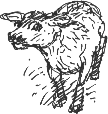 
Pebbles in my PocketFriday 24th March 2000, page 2/2
 I TAKE A SHORT WALK around the fields behind the British Geological Survey headquarters in Keyworth.
I TAKE A SHORT WALK around the fields behind the British Geological Survey headquarters in Keyworth.The lambs are out. One small lamb sees me from across the field, stops for a moment, as if it's just recognised me, races straight for me and starts sniffing around my shoes. This gives me a chance to pat its head and feel its thick springy wool. Still in a geological frame of mind, I pick up some pebbles. In this handful of pebbles there's a record of deserts, molten magma, vanished mountains, tropical seas, ice age glaciers and the activities of our ancestors;
Granite Granite chippings have been tipped on the farm track. This one has fleshy pink feldspar crystals, up to one centimetre long, set in a finer matrix of rock crystals. It is raining as I pick it up. Wetting a rock brings out its colour. Granite crystallises from molten magma in a chamber several kilometres below the surface of the earth It is associated with continental collisions which result in mountain-building. Apart from the Mount Sorrel 'granite' in Charnwood Forest near Leicester (which doesn't contain such large feldspar crystals) there are no local granites, so this was probably imported from Scotland or Scandinavia.
Granite chippings have been tipped on the farm track. This one has fleshy pink feldspar crystals, up to one centimetre long, set in a finer matrix of rock crystals. It is raining as I pick it up. Wetting a rock brings out its colour. Granite crystallises from molten magma in a chamber several kilometres below the surface of the earth It is associated with continental collisions which result in mountain-building. Apart from the Mount Sorrel 'granite' in Charnwood Forest near Leicester (which doesn't contain such large feldspar crystals) there are no local granites, so this was probably imported from Scotland or Scandinavia.The word feldspar comes from an old German miners' word meaning 'a rock crystal found in the fields'.
Desert sandstone This rough reddish sandstone pebble was probably originally part of a bed of desert sandstone. It may have been eroded and worked into a pebble in flash floods in a desert 230 million years ago, or by torrents of meltwater flowing from ice age glaciers 450,000 years ago (or both). There are a lot of these pebbles in the local boulder clay or till (debris left by the glaciers) which still covers parts of the local landscape.
This rough reddish sandstone pebble was probably originally part of a bed of desert sandstone. It may have been eroded and worked into a pebble in flash floods in a desert 230 million years ago, or by torrents of meltwater flowing from ice age glaciers 450,000 years ago (or both). There are a lot of these pebbles in the local boulder clay or till (debris left by the glaciers) which still covers parts of the local landscape.Some of the soil here is sandy, it crumbles to sand when you press it between your fingers.
Slate The slate, which I found amongst builder's rubble used to repair the track, was probably quarried in Wales for use as a roof tile. Welsh slate wasn't used nationwide until the railway network developed in Victorian times. Huge quarries in North Wales, including Llanberis at the foot of Snowdon, supplied the demand. Slate breaks along cleavage planes. These are the result of pressure during mountain-building episodes. Flaky crystals of mica in clay and mudstone reform at right-angles to the pressure exerted by colliding continents to give the rock its grain.
The slate, which I found amongst builder's rubble used to repair the track, was probably quarried in Wales for use as a roof tile. Welsh slate wasn't used nationwide until the railway network developed in Victorian times. Huge quarries in North Wales, including Llanberis at the foot of Snowdon, supplied the demand. Slate breaks along cleavage planes. These are the result of pressure during mountain-building episodes. Flaky crystals of mica in clay and mudstone reform at right-angles to the pressure exerted by colliding continents to give the rock its grain.
Flint Flint is a non-crystalline version of the mineral quartz which forms in cavities in which quartz-rich water circulates. This flint pebble is almost as smooth as glass, but it is harder than steel. Chemically it is a form of silica, SiO2, a compound that makes up 95% of the Earth's crust. Most of Britain's flint is associated with chalk. Chalk formed in a clear tropical sea which covered much of Europe at the time when dinosaurs such as Tyrannosaurus rex roamed on the land.
Flint is a non-crystalline version of the mineral quartz which forms in cavities in which quartz-rich water circulates. This flint pebble is almost as smooth as glass, but it is harder than steel. Chemically it is a form of silica, SiO2, a compound that makes up 95% of the Earth's crust. Most of Britain's flint is associated with chalk. Chalk formed in a clear tropical sea which covered much of Europe at the time when dinosaurs such as Tyrannosaurus rex roamed on the land.
A Great Spotted Woodpecker is drumming. There are plenty of traces of Rabbits in this little wood, and perhaps a few signs of Badger.
|
